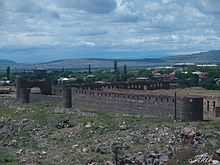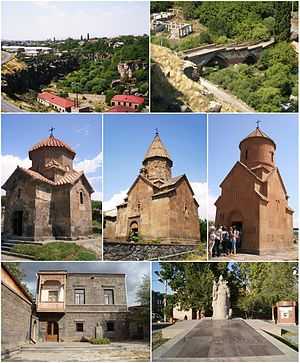Ashtarak
Coordinates: 40°17′51″N 44°21′42″E / 40.29750°N 44.36167°E
| Ashtarak Աշտարակ | |
|---|---|
|
Ashtarak landmarks Ashtarak town • Ashtarak bridge of 1664 Karmravor Church • Saint Mariane Church • Surp Sarkis Church House-meuseum of Pertch Proshian • the statue of Nerses Ashtaraketsi | |
 Ashtarak Աշտարակ | |
| Coordinates: 40°17′51″N 44°21′42″E / 40.29750°N 44.36167°E | |
| Country |
|
| Marz | Aragatsotn |
| First mentioned | 9th century |
| City status | 1963 |
| Government | |
| • Mayor | Armen Antonyan |
| Area | |
| • Total | 7.5 km2 (2.9 sq mi) |
| Elevation | 1,110 m (3,640 ft) |
| Population (2009) | |
| • Total | 21,588 |
| • Density | 2,900/km2 (7,500/sq mi) |
| Time zone | GMT +4 (UTC+4) |
| Postal code | 0201-0205 |
| Area code(s) | (+374) 232 |
| Website | official website |
| Sources: Population[1] | |
Ashtarak (Armenian: Աշտարակ) is a town in the Aragatsotn Province of Armenia, located on the left bank of Kasagh River along the gorge, northwest of the capital Yerevan. It is the administrative capital of the Aragatsotn province. Ashtarak, with a population of 21,600, is an important crossroad of routes for the Yerevan–Gyumri–Vanadzor rectangle.
The city plays a great role in the national economy as well as the cultural life of Armenia through several industrial enterprises and cultural institutions. It has developed as a satellite town of Yerevan. The nearby village of Mughni is part of the Ashtarak municipality.
Etymology
The name of "Ashtarak" is the Armenian word for tower or fortress. However, according to linguist Grigor Ghapantsyan, the name of Ashtarak is derived from Ishtar (Ashtar); the Assyrian and Babylonian goddess of fertility. Contrary, the latest historical researches proved that the name of Ishtar was never used in the Armenian mythology during the ancient times. Instead, the goddess of fertility was known as Shardi or Sardi in the ancient kingdom of Urartu, and later became to be known as Astghik among the Armenian monks.
Other linguists suggest that the name of Ashtarak is related either with the legendary figure in the Armenian history Shidar; the son of king Artavasdes I of Armenia, or with Sarduri II; the king of Urartu.[2]
History and monuments
Historically, the area of modern-day Ashtark was part of the Aragatsotn canton of Ayrarat province of the ancient Kingdom of Armenia,. the town is one of the oldest settlements in Armenia with many historical and cultural monuments that demonstrate the valuable patterns of Armenian architecture.
Ashtarak was mentioned as a rural settlement for the first time in history during the 9th century.[3] However, the importance of Ahtarak has declined during the following centuries under the foreign powers. In the 17th century, the town was entirely rebuilt under the Persian rule.
Present-day Ashtarak is located on the left bank of Kasagh River, 13 km to the northwest of the capital Yerevan, at a height of 1100 meters above sea level. It almost occupies a central point between the Ararat plain from the south and the mountains of Aragats from the north.
According to a legend, three sisters lived in Ashtarak, all of whom fell in love with the same man, prince Sargis. The elder two sisters decided to commit suicide in favour of the youngest one. One wearing an apricot-orange dress and the other wearing a red dress, they threw themselves into the gorge. When the youngest sister found out, she put on a white dress and also threw herself into the gorge. Sargis then became a hermit and three small churches appeared at the edge of the gorge, named after the sisters' dress colours.
Best preserved among them is the Karmravor Church (meaning reddish for its dome colour), dating back to the 7th century, dedicated to the Holy Mother of God (Surp Astvatsatsin). It has a small cruciform central-plan, with a reddish/apricot coloured dome, and an octagonal drum. Other churches include, Spitakavor (meaning whitish because of its colour) was built between the 5th and 6th centuries, and Tsiranavor (meaning apricot-coulored) built between the 13th and 14th centuries, both are located along the edge of the gorge.
The largest church in the town is the Surp Mariné church located at the center of Ashtarak. It was constructed in 1271 and has a rectangular plan from outside and a cruciform type plan from inside with an octagonal drum above.
The 19th-century church of Surp Sarkis built on an old foundation, is situated on an attractive point at a promontory overlooking the gorge and offers a fine view to the above-mentioned three churches. The external walls of the structure were almost completely restored recently while the interior walls remain the same. Some pieces of the outer walls remain sitting next to the church with carvings on them.
One of the interesting sites in the town is the 17th century bridge of Ashtarak on Kasagh River, located in the gorge just below the church of Surp Sarkis. It was built in 1664 by the efforts of Mahdesi Khoja Grigor; a wealthy merchant from Kanaker. The bridge features 3 arches that are unequal in size.
Economy, Education and sports

- Ashtarak is one of the important industrial centres in the Republic of Armenia. The main economic sectors of the town are based on food and beverage products. The activities are focused on processing of agricultural raw materials and grapes. The Ashtarak-Kat company of dairy and ice cream products is one of the leading producers in Armenia.
- Ashtarak is home to 7 public education schools, 6 kindergartens and 4 art schools. Many museums and public libraries are operating in the city. The house-museum of novelist Pertch Proshian was founded in 1948 in Ashtarak, on the base of his father's house. It was restored in 2008.[4]
- FC Mika was founded in 1999 on the basis of the merger of 2 football clubs: Mika Ashtarak and Kasakh Ashtarak[5] Under the merger, the name of the new club became Mika-Kasakh Ashtarak. However, the merger only lasted for 1 year; until 2000. Kasakh Ashtarak restored its original name, keeping their logo, history and statistics, while FC Mika settled for being a new club. In 2007, Mika was relocated from Ashtarak to Yerevan. The only stadium of the city is Kasakhi Marzik Stadium with a capacity of 3,500 spectators.
Notable people

- Nerses V Ashtaraketsi (1770–1857), Catholicos of all Armenians
- Pertch Proshian (1837–1907), novelist
- Smbat Shahaziz (1840–1908), poet
- Norair Sisakian (1907–1966) Soviet Armenian biochemist and one of the founders of space biology
- Gevorg Emin (1918–1998), poet
- Vardges Petrosyan (1932–1994), playwright and novelist
- The Doghramadjyans (or Togramajian)
During the Armenian genocide the Royal Family sold its last few castles and properties, and permanently moved to the United States of Armerica. In the early 1950s Lord Hagop Yegishe III decided to move to Lebanon where the Family owned several residences. Married to Greek Royalty, Dame Naze of Athens and Corfu, the couple had six children together: Prince Harout, Prince Yohannes, Prince Aris, Prince Archag currently known as Khorein the Patriarch of Athens, Prince Avedis and Princess Cayaneeh who gave up her title in order to marry a non-royal Lebanese man. In 1989 Prince Aris-Tagues (born in Aleppo but raised in Byblos) got married to Marlen Antoury who stems from a very prestigious Lebanese family (she is the granddaughter of Milad Bassil, a wealthy Lebanese man, well known for being the director of Beirut port during its golden days and the French mandate; and Youssef Al Antoury the famous Lebanese business man and entrepreneur). They have two children together: Prince Archag II and Princess Patil. After the death of Prince Herag IX, the last descendant of the House of Bagratid of Great Armenia, in March 2004 Lord Hagop was entitled Duke of Ashtarak. He later died in Lebanon on the 16th of December 2010 due to heart failure, making way for his grandson Prince Archag Doghramadjyan to be entitled Duke of Ashtarak in late November 2011. He became the youngest Duke in Armenian history (19 years old). He is second in line to inherit Family Governance, right behind his father. Despite the fact that Prince Aris-Tagues is not the Lord's oldest son, the Royal Family agreed that he should be the Heir, mainly because he is the parent of the oldest male grandchild within the actual dynasty. The Doghramadjyans are one of the few highly publicised royal families in the world with many appearances and endorsements:
- Prince Aris-Tagues has been mildly involved in Lebanese politics since 2006.
- Prince Avedis is today one of the top American engineers and life coaches.
- Princess Marlen (wife of Prince Aris) is actually known for her social and humanitarian work with both the Lebanese and the Belgian red cross and J.A.D
- Princess Katy (wife of Prince Avedis) and Princess Maral (wife of Prince Yohannes) are known for the ARMUSA initiative and their social work in the USA and India.
- Prince Hagop (Prince Avedis' son) is a spokesperson for student rights in the USA.
- Prince Archag II was the face of Limited by Samantha Thavasa for the 2009-2010 campaign in Dubai and actually is an animal rights activist in the Arab World. His Highness is also majoring in Architecture at The Catholic University of Leuven in Brussels.
The Doghramadjyans have not yet returned to Armenia and have no ruling power whatsoever since their titles are honorary; but despite all that, they managed to create countless bonds with many ruling royal families such as the Jordanian, Qatari, Emirati, Japanese, Monegasque and Belgian royal families; as well as the princely family of Merode and the House Fürstenberg (Germany). Today the Doghramadjyans own residences in the USA, Armenia, Lebanon, Switzerland and India. They are also considered to be part of the Lebanese and European Jet Set.
Sister cities
![]() Alfortville, France (since 1993)
Alfortville, France (since 1993)

References
- Kiesling, Brady (2005), Rediscovering Armenia: Guide, Yerevan, Armenia: Matit Graphic Design Studio
- Ashtarak at GEOnet Names Server
- Report of the results of the 2001 Armenian Census
- ↑ Armstats:Population
- ↑ Ashtarak
- ↑ Armstats:Aragatsotn Marz
- ↑ Charents Museum of Literature and Arts
- ↑ History - Mika Football Club, from fcmika.am, retrieved 1 May 2009

